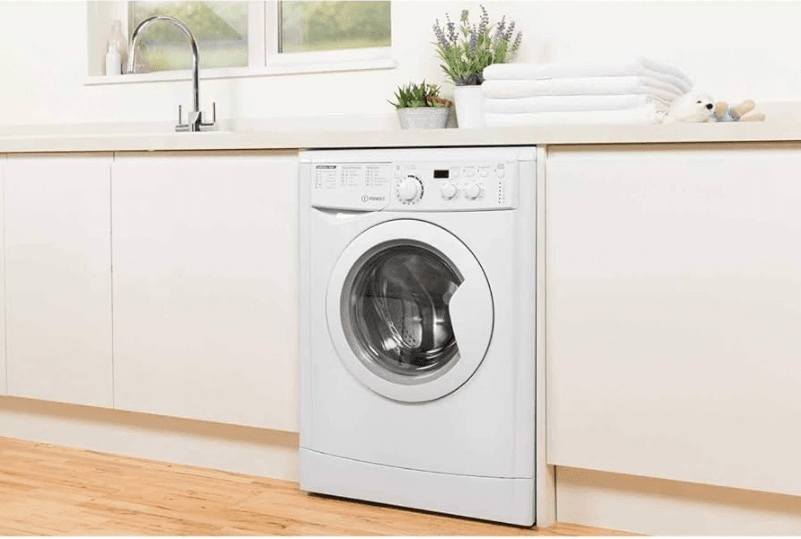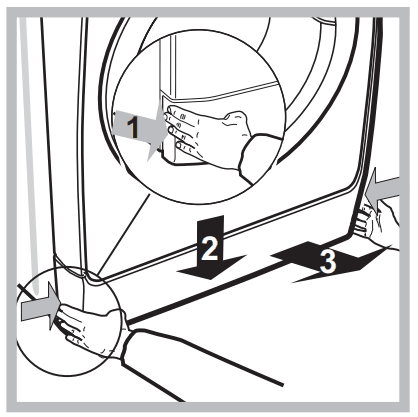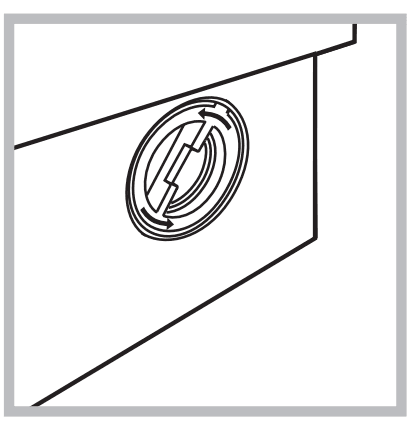
Indesit BWSC-61252 Washing Machine

Installation
- This instruction manual should be kept in a safe place for future reference. If the washing machine is sold, transferred or moved, make sure that the instruction manual remains with the machine so that the new owner is able to familiarise himself/herself with its operation and features.
- Read these instructions carefully: they contain vital information relating to the safe installation and operation of the appliance.
Unpacking and levelling
Unpacking
- Remove the washing machine from its packaging.
- Make sure that the washing machine has not been damaged during the transportation process. If it has been damaged, contact the retailer and do not proceed any further with the installation process.
- Remove the 4 protective screws (used during transportation) and the rubber washer with the corresponding spacer, located on the rear part of the appliance (see figure).
- Close off the holes using the plastic plugs provided.
- Keep all the parts in a safe place: you will need them again if the washing machine needs to be moved to another location.
- Packaging materials should not be used as toys for children.
Levelling
- Install the washing machine on a flat, sturdy floor, without resting it up against the walls, furniture
cabinets or anything else. - If the floor is not perfectly level, compensate for any unevenness by tightening or loosening the
Adjustable front feet (see figure); the angle of inclination, measured in relation to the worktop, must not exceed 2°.
Levelling the machine correctly will provide it with stability, help to avoid vibrations and excessive noise, and prevent it from shifting while it is operating. If it is placed on carpet or a rug, adjust the feet in such a way as to allow sufficient ventilation space underneath the washing machine.
Connecting the electricity and water supplies
Connecting the water inlet hose
- Connect the supply pipe by screwing it to a cold water tap using a ¾ gas threaded connection (see
figure). Before performing the connection, allow the water to run freely until it is perfectly clear. - Connect the inlet hose to the washing machine by screwing it onto the corresponding water inlet of the appliance, which is situated on the top right-hand side of the rear part of the appliance (see figure).
- Make sure that the hose is not folded over or bent.
- The water pressure at the tap must fall within the range of values indicated in the Technical data table (see next page).
- If the inlet hose is not long enough, contact a specialised shop or an authorised technician.
- Never use second-hand hoses.
- Use the ones supplied with the machine.
Connecting the drain hose
Connect the drain hose, without bending it, to a draining duct or a wall drain situated between 65 and 100 cm from the floor;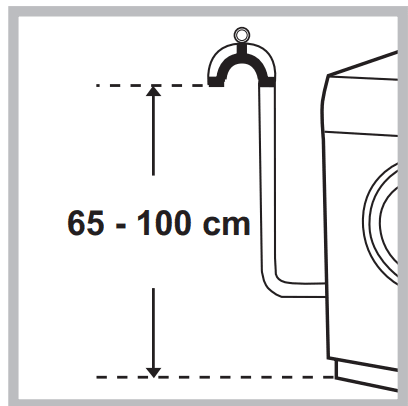
The drain hose may be connected to an under-sink trap. Before connecting the drain hose from the machine ensure that any blanks or removable ends have been taken off the spigot.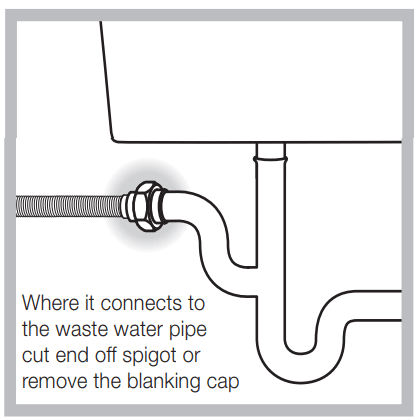
If it is placed over the edge of a basin or sink, be sure the free end of the hose is not underwater.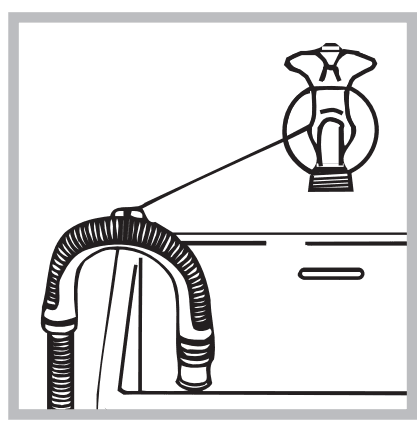
- We advise against the use of hose extensions; in case of absolute need, the extension must have the same diameter as the original hose and must not exceed 150 cm in length. Ensure that if the drain hose is pushed into a standpipe, the end does not go down more than 15 cm (6 inches). If the hose is pushed down too far, this may cause the machine to self-syphon ie. continuously empty as it is filling.
Electric connection
Before plugging the appliance into the mains socket, make sure that:
- The socket is earthed and in compliance with the applicable law.
- The socket is able to sustain the appliance’s maximum power load indicated on the Technical Data Plate fixed on the machine;
- The supply voltage is included within the values indicated on the Technical Data Plate fixed on
the machine. - the socket is compatible with the washing machine’s plug. If this is not the case, replace the socket or the plug.
Your appliance is now supplied with a 13 amp fused plug, which can be plugged into a 13 amp socket for immediate use. Before using the appliance, please read the instructions below.
WARNING – THIS APPLIANCE MUST BE EARTHED. THE FOLLOWING OPERATIONS SHOULD BE CARRIED OUT BY A QUALIFIED ELECTRICIAN.
Replacing the fuse:
When replacing a faulty fuse, a 13 amp ASTA-approved fuse to BS 1362 should always be used, and the fuse cover re-fitted. If the fuse cover is lost, the plug must not be used until a replacement is obtained.
Replacement fuse covers: If a replacement fuse cover is fitted, it must be of the correct colour as indicated by the coloured marking or the colour that is embossed in words on the base of the plug. Replacements can be obtained directly from your nearest Service Depot.
Removing the plug:
If your appliance has a non-rewireable moulded plug and you wish to re-route the mains cable through partitions, units etc., please ensure that either: the plug is replaced by a fused 13 ampere rewireable plug bearing the BSI mark of approval or: the mains cable is wired directly into a 13 amp cable outlet, controlled by a switch (in compliance with BS 5733), which is accessible without moving the appliance.
Disposing of the plug:
Ensure that before disposing of the plug itself, you make the pins unusable so that it cannot be
accidentally inserted into a socket.
Instructions for connecting the cable to an alternative plug:
Important: the wires in the mains lead are coloured by the following code:
- Green & Yellow
- Earth
- Blue
- Neutral
- Brown
- Live
As the colours of the wires in the lead may not correspond with the coloured markings identifying the terminals in your plug, proceed as follows:
- Connect the Green & Yellow wire to the terminal marked E or coloured Green or Green & Yellow.
- Connect the Brown wire to the terminal marked L or coloured Red.
- Connect the Blue wire to the terminal marked N or coloured Black.
If a 13 amp plug (BS 1363) is used it must be fitted with a 13 amp fuse, either in the plug or adaptor or at the distribution board. If you are in any doubt regarding the electrical supply to your machine, consult a qualified electrician before use.
How to connect an alternative plug:
The wires in this mains lead are coloured in accordance with the following code:
- BLUE
- NEUTRAL (N)
- BROWN
- LIVE (L)
- GREEN & YELLOW
- EARTH (E)
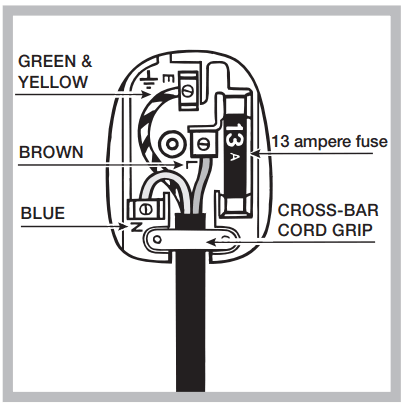
Disposing of the appliance:
When disposing of the appliance, please remove the plug by cutting the mains cable as close as possible to the plug body and dispose of it as described above.
- The washing machine should not be installed in an outdoor environment, not even where the area is sheltered, because it may be very dangerous to leave it exposed to damp, rain and thunderstorms.
- When the washing machine is installed, the mains socket must be within easy reach.
- Do not use extensions or multiple sockets.
- The power supply cable must never be bent or dangerously compressed.
- The power supply cable must only be replaced by an authorised serviceman.
Warning! The company denies all liability if and when these norms are not respected.
The first wash cycle
Once the appliance has been installed, and before you use it for the first time, run a wash cycle with detergent and no laundry, using the wash cycle “Auto Clean” (see “Cleaning the washing machine”).
| Technical data | |
| Model | BWSC 61252 |
| Dimensions | width 59.5 cm height 85 cm depth 42.5 cm |
| Capacity | from 1 to 6 kg |
| Electrical connections | Please refer to the technical data plate fixed to the machine |
| Water connections | maximum pressure 1 MPa (10 bar) minimum pressure 0.05 MPa (0.5 bar) drum capacity 40 litres |
| Spin speed | up to 1200 rotations per minute |
| Test wash cycles in accordance with regulations 1061/2010 and 1015/2010. | Programme 9: Eco Cotton 60°. Programme 9: Eco Cotton 40°. |
| This appliance conforms to the following EC Directives: – EMC 2014/30/EU (Electro-magnetic Compatibility) – LVD 2014/35/EU (Low Voltage) – 2012/19/EU (WEEE) | |
Care and maintenance
Cutting off the water and electricity supplies
- Turn off the water tap after every wash cycle. This will limit wear on the hydraulic system inside the washing machine and help to prevent leaks.
- Unplug the washing machine when cleaning it and during all maintenance work.
Cleaning the washing machine
- The appliance’s outer parts and rubber components can be cleaned using a soft cloth soaked in lukewarm soapy water. Do not use solvents or abrasives.
- The washing machine has an “Auto Clean” programme for its internal parts that must run with no drum load.
For maximum performance, you may want to use either the detergent (i.e. a quantity 10% of the quantity specified for lightly-soiled garments) or special additives to clean the washing machine. We recommend running a cleaning programme every 40 wash cycles. To start the programme press buttons A and
B simultaneously for 5 seconds (see figure). The programme will start automatically and will last approximately 75 minutes. To stop the cycle, press the START/PAUSE button.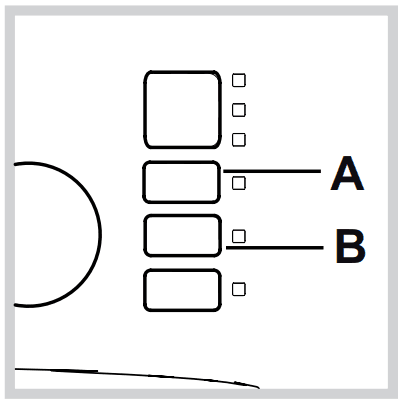
Cleaning the detergent dispenser drawer
To remove the drawer, press lever (1) and pull the drawer outwards (2) (see figure). Wash it under running water; this procedure should be repeated frequently.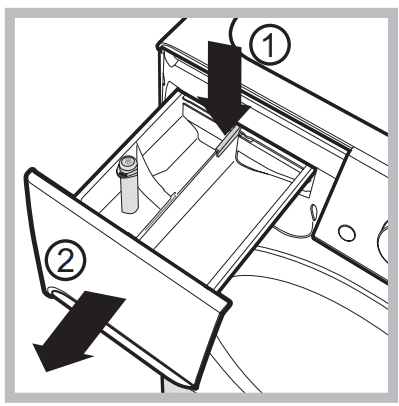
Caring for the door and drum of your appliance
- Always leave the porthole door ajar in order to prevent unpleasant odours from forming.
Cleaning the pump
The washing machine is fitted with a self-cleaning pump which does not require any maintenance. Sometimes, small items (such as coins or buttons) may fall into the protective pre-chamber at the base of the pump.
- Make sure the wash cycle has finished and unplug the appliance.
To access the pre-chamber:
- Take off the cover panel on the front of the machine by first pressing it in the centre and then pushing downwards on both sides until you can remove it (see figures).

- Unscrew the lid by rotating it anticlockwise (see figure): a little water may trickle out. This is perfectly normal.

- Clean the inside thoroughly.
- Screw the lid back on.
- Reposition the panel, making sure the hooks are securely in place before you push it onto the appliance.
Checking the water inlet hose
Check the inlet hose at least once a year. If there are any cracks, it should be replaced immediately: during the wash cycles, water pressure is very strong and a cracked hose could easily split open.
- Never use second-hand hoses.
Precautions and tips
- This washing machine was designed and constructed in accordance with international safety regulations. The following information is provided for safety reasons and must therefore be read carefully.
General safety
- This appliance was designed for domestic use only.
- This appliance can be used by children aged 8 years and above and persons with reduced physical, sensory or mental capabilities or lack of experience and knowledge if they have been given supervision or instruction concerning use of the appliance in a safe way and understand the hazards involved. Children shall not play with the appliance. Cleaning and user maintenance shall not be made by children without supervision.
- The washing machine must only be used by adults, in accordance with the instructions provided in this manual.
- Do not touch the machine when barefoot or with wet or damp hands or feet.
- Do not pull on the power supply cable when unplugging the appliance from the electricity socket. Hold the plug and pull.
- Do not open the detergent dispenser drawer while the machine is in operation
- Do not touch the drained water as it may reach extremely high temperatures.
- Never force the porthole door. This could damage the safety lock mechanism designed to prevent accidental opening.
- If the appliance breaks down, do not under any circumstances access the internal mechanisms in an attempt to repair it yourself.
- Always keep children well away from the appliance while it is operating.
- The door can become quite hot during the wash cycle.
- If the appliance has to be moved, work in a group of two or three people and handle it with the utmost care. Never try to do this alone, because the appliance is very heavy.
- Before loading laundry into the washing machine, make sure the drum is empty.
Load balancing system
Before every spin cycle, to avoid excessive vibrations and to distribute the load in a uniform manner, the drum rotates continuously at a speed which is slightly greater than the washing rotation speed. If, after several attempts, the load is not balanced correctly, the machine spins at a reduced spin speed. If the load is excessively unbalanced, the washing machine performs the distribution process instead of spinning. To encourage improved load distribution and balance, we recommend that small and large garments be mixed in the load.
Disposal
- Disposing of the packaging materials: observe local regulations so that the packaging may be re-used.
- The European Directive 2012/19/EU – WEEE on Waste Electrical and Electronic Equipment requires that old household electrical appliances must not be disposed of in the normal unsorted municipal waste stream. Old appliances must be collected separately in order to optimise the recovery and recycling of the materials they contain and reduce the impact on human health and the environment. The crossed out “wheeled bin” symbol on the product reminds you of your obligation, that when you dispose of the appliance, it must be separately collected. Consumers should contact their local authority or retailer for information concerning the correct disposal of their old appliance.
Description of the washing machine and starting a wash cycle
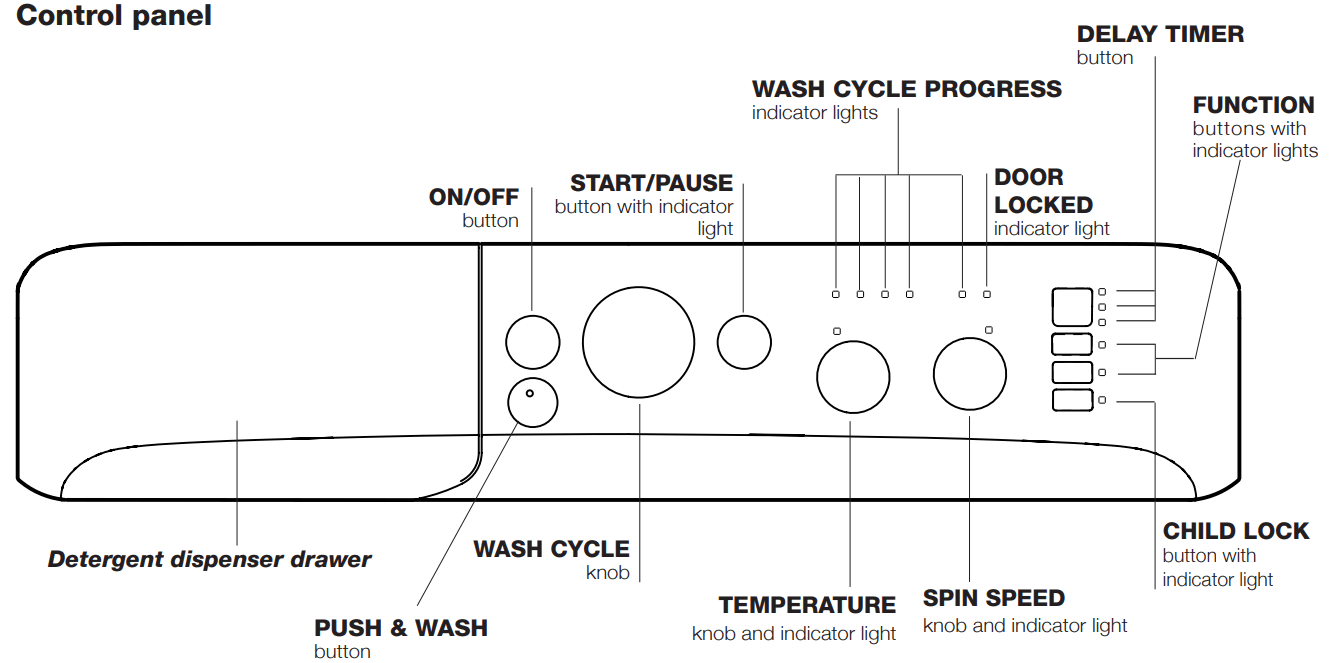
- Detergent dispenser drawer: used to dispense detergents and washing additives (see “Detergents and laundry”).
- ON/OFF button: switches the washing machine on and off.
- PUSH & WASH button: (see “Wash cycles”).
- WASH CYCLE knob: programmes the wash cycles. During the wash cycle, the knob does not move.
- FUNCTION buttons with indicator light: used to select the available functions. The indicator light corresponding to the selected function will remain lit.
- CHILD LOCK button with indicator light: To activate the control panel lock, press and hold the button for approximately 2 seconds. When the indicator light is illuminated, the control panel is locked (apart from the ON/OFF button). This means it is possible to prevent wash cycles from being modified accidentally, especially where there are children in the home. To deactivate the control panel lock, press and hold the button for approximately 2 seconds.
- TEMPERATURE knob and indicator light: sets the temperature or the cold wash cycle (see “Personalisation”).
- SPIN SPEED knob and indicator light: sets the spin speed or exclude the spin cycle completely (see “Personalisation”).
- DELAY TIMER button: delays the start of the wash cycle by up to 9 hours. Press the button repeatedly until the indicator light corresponding to the desired delay time turns on. When the button is pressed for the fourth time, the option will be deactivated.
- WASH CYCLE PROGRESS indicator lights: used to monitor the progress of the wash cycle. The illuminated indicator light shows which phase is in progress.
- DOOR LOCKED indicator light: indicates whether the door may be opened or not (see next page).
- START/PAUSE button with indicator light: starts or temporarily interrupts the wash cycles. N.B. To pause the wash cycle in progress, press this button; the corresponding indicator light will flash orange, while the indicator light for the current wash cycle phase will remain lit in a fixed manner. If the DOOR LOCKED indicator light is switched off, the door may be opened
(wait approximately 3 minutes). To start the wash cycle from the point at which it was interrupted,
Press this button again. - Standby mode: This washing machine, in compliance with new energy saving regulations, is fitted with an automatic standby system which is enabled after about 30 minutes if no activity is detected. Press the ON-OFF button briefly and wait for the machine to start up again.
Indicator lights
The indicator lights provide important information. This is what they can tell you:
Delayed start
If the DELAY TIMER function has been activated (see “Personalisation”), after the wash cycle has been started the indicator light corresponding to the selected delay period will begin to flash: As time passes, the remaining delay will be displayed and the corresponding indicator light will flash:
As time passes, the remaining delay will be displayed and the corresponding indicator light will flash: The set programme will start once the selected time delay has expired.
The set programme will start once the selected time delay has expired.
Troubleshooting
Your washing machine could fail to work. Before contacting the Technical Assistance Centre (see “Assistance”), make sure that the problem cannot be solved easily using the following list.
Product Guarantee and Repair Information
Guarantee
12 Months Parts and Labour Guarantee
Your appliance has the benefit of our manufacturer’s guarantee, which covers the cost of breakdown repairs for twelve months from the date of purchase. This gives you the reassurance that if, within that time, your appliance is proven to be defective because of either workmanship or materials, we will, at our discretion, either repair or replace the appliance at no cost to you: This guarantee is subject to the following conditions:
- The appliance has been installed and operated correctly and in accordance with our operating and
Maintenance instructions. - The appliance is used only on the electricity or gas supply printed on the rating plate.
- The appliance has been used for normal domestic purposes only.
- The appliance has not been altered, serviced, maintained, dismantled, or otherwise interfered with
by any person not authorised by us. - Any repair work must be undertaken by us or our appointed agent.
- Any parts removed during repair work or any appliance that is replaced becomes our property.
- The appliance is used in the United Kingdom or the Republic of Ireland. The guarantee does not cover:
- Damage resulting from transportation, improper use, neglect or interference or as a result of improper installation.
- Replacement of any consumable item or accessory. These include but are not limited to: plugs, cables, batteries, light bulbs, fluorescent tubes and starters, covers and filters.
- Replacement of any removable parts made of glass or plastic.
THIS GUARANTEE WILL NOT APPLY IF THE APPLIANCE HAS BEEN USED IN COMMERCIAL OR NON-DOMESTIC PREMISES.
For more manuals by Indesit, visit ManualsLibraryy
Indesit BWSC-61252 Washing Machine-FAQs
What do the buttons on the Indesit washing machine mean?
1. ON/OFF: Turns the machine on or off.
2. WASH CYCLE knob: Lets you select different wash programs (this knob doesn’t rotate during the cycle).
3. FUNCTION buttons: Used to activate specific features. A light stays on to show the function is active.
What is the “2 sec” Push & Wash button?
This button starts a quick 45-minute wash cycle at 30°C. Just hold it for 2 seconds. It’s great for cotton and synthetic clothes, handling loads up to 4 kg.
Why did my Indesit washer stop mid-cycle?
A common reason is the cold water supply being turned off. Make sure the water supply is on, especially if it stops during the rinse cycle.
Why does my wash cycle take so long?
Wash times vary depending on the load type and program. Bulky loads or cycles like “Sanitize” can take much longer than “Quick Wash” or “Normal” modes.
Which washing mode should I use?
1. Cotton/Normal: For everyday cotton items like shirts and towels.
2. Synthetic/Daily: Best for synthetic clothes.
3. Mixed Soiled+: Good for mixed fabric loads.
4. Cradle Wash: Designed for delicate clothing.
What is the Auto Clean cycle?
This program cleans the inside of the machine without any clothes inside. Use a small amount of detergent or a cleaning additive for best results.
How long does the Spin and Drain cycle take?
The spin cycle usually takes about 10 minutes and is used to remove extra water from clothes.
What does Rinse and Spin mode do?
It rinses your clothes with clean water and then spins them to remove moisture—no detergent is used.

